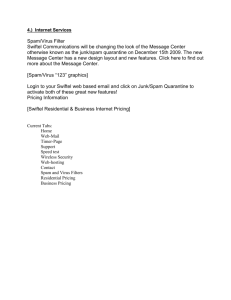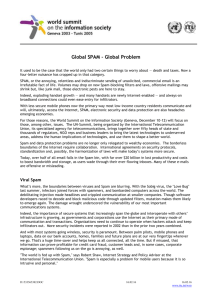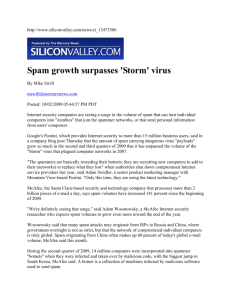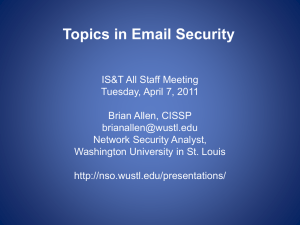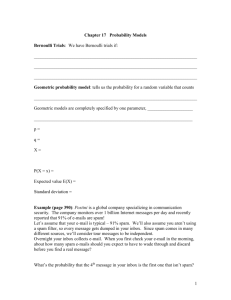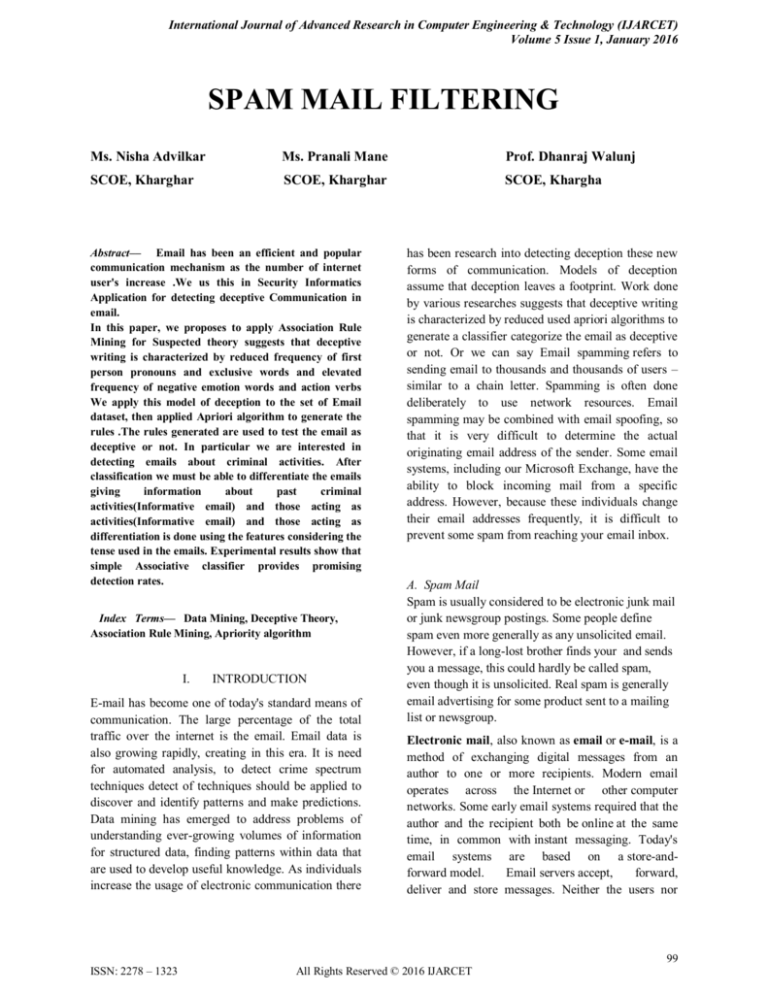
International Journal of Advanced Research in Computer Engineering & Technology (IJARCET)
Volume 5 Issue 1, January 2016
SPAM MAIL FILTERING
Ms. Nisha Advilkar
Ms. Pranali Mane
Prof. Dhanraj Walunj
SCOE, Kharghar
SCOE, Kharghar
SCOE, Khargha
Abstract–– Email has been an efficient and popular
communication mechanism as the number of internet
user's increase .We us this in Security Informatics
Application for detecting deceptive Communication in
email.
In this paper, we proposes to apply Association Rule
Mining for Suspected theory suggests that deceptive
writing is characterized by reduced frequency of first
person pronouns and exclusive words and elevated
frequency of negative emotion words and action verbs
We apply this model of deception to the set of Email
dataset, then applied Apriori algorithm to generate the
rules .The rules generated are used to test the email as
deceptive or not. In particular we are interested in
detecting emails about criminal activities. After
classification we must be able to differentiate the emails
giving
information
about
past
criminal
activities(Informative email) and those acting as
activities(Informative email) and those acting as
differentiation is done using the features considering the
tense used in the emails. Experimental results show that
simple Associative classifier provides promising
detection rates.
Index Terms–– Data Mining, Deceptive Theory,
Association Rule Mining, Apriority algorithm
I.
INTRODUCTION
E-mail has become one of today's standard means of
communication. The large percentage of the total
traffic over the internet is the email. Email data is
also growing rapidly, creating in this era. It is need
for automated analysis, to detect crime spectrum
techniques detect of techniques should be applied to
discover and identify patterns and make predictions.
Data mining has emerged to address problems of
understanding ever-growing volumes of information
for structured data, finding patterns within data that
are used to develop useful knowledge. As individuals
increase the usage of electronic communication there
has been research into detecting deception these new
forms of communication. Models of deception
assume that deception leaves a footprint. Work done
by various researches suggests that deceptive writing
is characterized by reduced used apriori algorithms to
generate a classifier categorize the email as deceptive
or not. Or we can say Email spamming refers to
sending email to thousands and thousands of users –
similar to a chain letter. Spamming is often done
deliberately to use network resources. Email
spamming may be combined with email spoofing, so
that it is very difficult to determine the actual
originating email address of the sender. Some email
systems, including our Microsoft Exchange, have the
ability to block incoming mail from a specific
address. However, because these individuals change
their email addresses frequently, it is difficult to
prevent some spam from reaching your email inbox.
A. Spam Mail
Spam is usually considered to be electronic junk mail
or junk newsgroup postings. Some people define
spam even more generally as any unsolicited email.
However, if a long-lost brother finds your and sends
you a message, this could hardly be called spam,
even though it is unsolicited. Real spam is generally
email advertising for some product sent to a mailing
list or newsgroup.
Electronic mail, also known as email or e-mail, is a
method of exchanging digital messages from an
author to one or more recipients. Modern email
operates across the Internet or other computer
networks. Some early email systems required that the
author and the recipient both be online at the same
time, in common with instant messaging. Today's
email systems are based on a store-andforward model.
Email servers accept,
forward,
deliver and store messages. Neither the users nor
99
ISSN: 2278 – 1323
All Rights Reserved © 2016 IJARCET
International Journal of Advanced Research in Computer Engineering & Technology (IJARCET)
Volume 5 Issue 1, January 2016
their computers are required to be online
simultaneously; they need connect only briefly,
typically to an email server, for as long as it takes to
send or receive messages. An Internet email message
consists of three components, the message envelope,
the message header, and the message body. The
message header contains control information,
including,
minimally,
an
originator's email
address and one or more recipient addresses. Usually
descriptive information is also added, such as a
subject header field and a message submission
date/time stamp.
rule { milk, bread} => {butter} has a confidence
of 0.2 / 0.4 = 0.5 in the database, which means
that for 50% of the transactions containing milk
and bread the rule is correct (50% of the times a
customer buys milk and bread, butter is bought
as well). Be careful when reading the
expression: here supp (X∪Y) means "support for
occurrences oftransactions where X and Y both
appear", not "support for occurrences of
transaction swhere either X or Y appears", the
latter interpretation arising because set union is
equivalent to logical disjunction. The argument
of supp() is a set of preconditions, and thus
becomes more restrictive as it grows (instead of
more inclusive).
B. Association Rule
In data mining, association rule learning is a
popular and well researched method for discovering
interesting relations between variables in large
databases.
For
example,
the
rule {Onion,Potato}=>{Burger} found in the sales
data of a supermarket would indicate that if a
customer buys onions and potatoes together, he or
she is likely to also buy hamburger meat. Such
information can be used as the basis for decisions
about marketing activities such as, e.g.,
promotional pricing or product
placements.
In
addition to the above example from market basket
analysis association rules are employed today in
many application areas including web usage
mining, intrusion detection and bioinformatics. As
opposed to sequence mining, association rule
learning typically does not consider the order of
items either within a transaction or across
transactions.
C. Useful Concepts
To select interesting rules from the set of all possible
rules, constraints on various measures of significance
and interest can be used. The best-known constraints
are minimum thresholds on support and confidence.
The supportsup(X) of an item set X is defined as
the proportion of transactions in the data set
which contain the item set. In the example
database, the item set {milk, bread, butter} has a
support of 1/5=0.2 since it occurs in 20% of all
transactions (1 out of 5 transactions).
The confidence of a rule is defined conf (X=>Y)
= supp (X U Y) / supp (X). For example, the
Confidence can be interpreted as an estimate of
the probability P (Y|X), the probability of
finding the RHS of the rule in transactions
under the condition that these transactions also
contain the LHS.
II.
LITERATURE SURVEY
A. Email Spam and the CAN-SPAM Act
In December 2003, the CAN-SPAM Act was enacted
and took effect in January 2004 (Lee, 2005). The Act
was enacted in an attempt to regulate interstate
commerce by imposing penalties and limitations on
sending unsolicited commercial email via the Internet
(Year gain et al., 2004). The Federal Trade
Commission (FTC) was authorized to enforce
provisions provided in the CAN-SPAM Act, and
unsolicited commercial emails that fail to comply
with its regulations were declared criminal. The
punishment could be a fine up to $16,000 for each
separate email in violation of the CAN-SPAM Act
(FTC, 2009), or it could be imprisonment (Year gain
et al., 2004). In 2008, the so-called ―Spam King‖
Robert Soloway was convicted under the CANSPAM Act for sending fraudulent emails along with
two other charges and was sentenced to 47 months in
federal prison (Rabinovitch, 2007). The Act also
allows states and Internet service providers to file
civil lawsuits against spammers (Ford, 2005; Year
gain et al., 2004).
Email spam is a rampant activity in cyberspace. This
study performed a qualitative forensic analysis on
3,983 spam emails with respect to their content,
100
ISSN: 2278 – 1323
All Rights Reserved © 2016 IJARCET
International Journal of Advanced Research in Computer Engineering & Technology (IJARCET)
Volume 5 Issue 1, January 2016
format, techniques, and their compliance with the
CAN-SPAM Act. The findings suggested spammers
show little interest in complying with the CANSPAM Act, and different purposes of spam determine
B. Existing System
Apriori algorithm for Association -rules generation
The association rules generated is in
numerical values hence the visualized output
with respect to the output column of the
preprocessing. Association Rule mining
searches for interesting association or
correlation relationships among items in a
given large data set. We model email
messages as transaction where items are
words or phrases from the email. After
preprocessing a email message, by
eliminating stop words and stemming.
It's hard to remember what our lives were
like without email. Ranking up there with
the web as one of the most useful features of
the Internet, billions of messages are sent
each year. Though email was originally
developed for sending simple text messages,
it has become more robust in the last few
years. So, it is one possible source of data
from which potential problem can be
detected. Thus the problem is to find a
system that identifies the .deception in
communication through emails.
C. Name of Different Methods
Content-Based Filters
Content-based filtering, also referred to as cognitive
filtering, recommends items based on a comparison
between the content of the items and a user profile.
The content of each item is represented as a set of
descriptors or terms, typically the words that occur in
a document. The user profile is represented with the
same terms and built up by analyzing the content of
items which have been seen by the user.
Several issues have to be considered when
implementing a content-based filtering system. First,
terms can either be assigned automatically or
manually. When terms are assigned automatically a
method has to be chosen that can extract these terms
from items. Second, the terms have to be represented
such that both the user profile and the items can be
the format and the techniques spammers use. The
rationales behind these spam choices were discussed.
Legal and research implications were suggested.
compared in a meaningful way. Third, a learning
algorithm has to be chosen that is able to learn the
user profile based on seen items and can make
recommendations based on this user profile.
The information source that content-based filtering
systems are mostly used with are text documents. A
standard approach for term parsing selects single
words
from
documents.
The vector
space
model and latent semantic indexing are two methods
that use these terms to represent documents as
vectors in a multidimensional space.
Rather than enforcing across-the-board policies for
all messages from a particular email or IP address,
content-based filters evaluate words or phrases found
in each individual message to determine whether an
email is spam or legitimate.
Word-Based Filters
A word-based spam filter is the simplest type of
content-based filter. Generally speaking, word-based
filters simply block any email that contains certain
terms. Since many spam messages contain terms not
often found in personal or business communications,
word filters can be a simple yet capable technique for
fighting junk email. However, if configured to block
messages containing more common words, these
types of filters may generate false positives. For
instance, if the filter has been set to stop all messages
containing the word "discount," emails from
legitimate senders offering your non-profits hardware
or software at a reduced price may not reach their
destination. Also note that since spammers often
purposefully misspell keywords in order to evade
word-based filters, your IT staff will need to make
time to routinely update the filter's list of blocked
words.
Heuristic Filters
Heuristic filtering works by subjecting email
messages through thousands of pre-defined rules
against the message envelope, header and content.
Each rule assigns a numerical score to the probability
of the message being spam. The result of the final
101
ISSN: 2278 – 1323
All Rights Reserved © 2016 IJARCET
International Journal of Advanced Research in Computer Engineering & Technology (IJARCET)
Volume 5 Issue 1, January 2016
equation is known as the Spam Score .The spam
score is then measured against the user’s desired
level of spam sensitivity - whether low, medium or
high sensitivity. Setting a higher level of sensitivity
leads to more spam being captured, but has the
adverse effect of filtering legitimate emails as spam.
This is known as a false-positive.
Heuristic (or rule-based) filters take things a step
beyond simple word-based filters. Rather than
blocking messages that contain a suspicious word,
heuristic filters take multiple terms found in an email
into consideration. Heuristic filters scan the contents
of incoming emails and assigning points to words or
phrases. Suspicious words that are commonly found
in spam messages, such as "Rolex" or "Viagra,"
receive higher points, while terms frequently found in
normal emails receive lower scores. The filter then
adds up all the points and calculates a total score. If
the message receives a certain score or higher
(determined by the anti-spam application's
administrator), the filter identifies it as spam and
blocks it. Messages that score lower than the target
number are delivered to the user.
Heuristic filters work fast — minimizing email delay
— and are quite effective as soon as they have been
installed and configured. However, heuristic filters
configured to be aggressive may generate false
positives if a legitimate contact happens to send an
email containing a certain combination of words.
Similarly, some savvy spammers might learn which
words to avoid including, thereby fooling the
heuristic filter into believing they are benign senders.
Bayesian Filters
Bayesian filters, considered the most advanced form
of content-based filtering, employ the laws of
mathematical probability to determine which
messages are legitimate and which are spam. In order
for a Bayesian filter to effectively block spam, the
end user must initially "train" it by manually flagging
each message as either junk or legitimate. Over time,
the filter takes words and phrases found in legitimate
emails and adds them to a list; it does the same with
terms found in spam.
D. A Review on Different Spam Detection Approach
Rafiqul Islam and Yang Xiang[3] performed
classification of user emails form penetration of
spam. In their paper,‖ Email Classification Using
Data Reduction Method‖ an effective and efficient
email classification technique based on data filtering
method is presented. They have introduced an
innovative filtering technique using instance selection
method (ISM) to reduce the pointless data instances
from training model and then classify the test data.
The objective of ISM is to identify which instances
(examples, patterns) in email corpora should be
selected as representatives of the entire dataset,
without significant loss of information. They have
used WEKA interface in our integrated classification
model and tested diverse classification algorithms.
Their empirical studies show significant performance
in terms of classification accuracy with reduction of
false positive instances.
AsmeetaMali[4] performed a work,‖ Spam Detection
using Bayesian with Pattern Discovery‖. In her paper
she presents an effective technique to improve the
effectiveness of using and updating discovered
patterns for finding relevant and interesting
information. Using Bayesian filtering algorithm and
effective pattern Discovery technique we can detect
the spam mails from the email dataset with good
correctness of term.
Vandana Jaswal[5] proposes an image spam
detection system that uses detect spam words. In her
work,‖ Spam Detection System Using Hidden
Markov Model‖ filtering method are used to detect
stemming words of spam images and then use
Hidden Markov Model of spam filters to detect all
the spam images
III.
PROPOSED SYSTEM
Based on the theory of deception a deceptive email
will have highly emotional words and action verbs.
So, such words are set as keywords and extracted
from the input dataset. Example for highly emotional
words and action verbs are ―lifeless‖, ―anger‖, ―kill‖,
―attack‖, etc. The future tense denoting keywords
such as will, shall, may, might, should, can, could,
would are used to indicate that the suspicious email is
of the type alert. The past tense denoting keywords
such as was, were, etc. are used to indicate that the
suspicious email is of the informative type. After
102
ISSN: 2278 – 1323
All Rights Reserved © 2016 IJARCET
International Journal of Advanced Research in Computer Engineering & Technology (IJARCET)
Volume 5 Issue 1, January 2016
these email is given to the preprocessing program.
This system gives the pure classification of the email
message on the users screen. So that user can easily
categorize the received emails at his/her side.
Figure Difference between types of email
IV.
Figure Classification of Email
CONCLUSION
In this project, we have deployed Association rule
mining based classification approach to detect
deceptive communication in email text as informative
or alert emails. We can find it that the simple Apriori
algorithm can provides better classification result for
suspicious email detection The Proposed work
(using keyword extraction and keyword attribute
called tense) will be helpful for identifying the
deceptive email and to get information in time to
take effective actions to reduce criminal activities.
V.
FUTURE SCOPE
In the near future, we plan to incorporate other
techniques like different ways of feature selection,
and classification using other methods. One major
advantage of the association rule based classifier is
that it does not assume that terms are independent
and its training is relatively fast. Furthermore the
rules are human understandable and easy to
maintained or pruned by human being.
REFERENCES
[1] S.Appavu alias Balamurgan, Aravind, Athiappan, Bharathiraja,
Muthu Pandian and Dr.R.Rajaram ―Association Rule Mining for
Suspicious Email Detection: A Data Mining Approach‖ 2007
Figure Types of email
[2] http://en.wikipedia.org/wiki/Apriori_algorithm
103
ISSN: 2278 – 1323
All Rights Reserved © 2016 IJARCET
International Journal of Advanced Research in Computer Engineering & Technology (IJARCET)
Volume 5 Issue 1, January 2016
[3] Rafiqul Islam and Yang Xiang ,‖ Email Classification Using
Data Reduction Method‖
[9] Zan Huang and Daniel D.Zeng, ―A link Prediction approach to
anomalous email Detection‖
[4] Asmeeta Mali, ‖ Spam Detection using Bayesian with Pattern
Discovery‖
[10] J.Rennie ,‖An Application of Machine Learning to email
Filtering,‖ In proc. KDD 2000 workshop on Text mining, Boston,
MA 2000
[5] VandanaJaswal, ‖ Spam Detection System Using Hidden
Markov Model‖
[6] R.Agrawal and R.Srikant, "Fast algorithms for mining
association rules," In Proc. 20th Int. Conf. Very Large Data Bases
(VLDB'94), pages 487-499, Santiago, Chile, 1994.
[7] G. Boone. "Concept features in re:agent, an intelligent email
agent," In Proc. 2nd Int. Conf. Autonomous Agents (Agents'98),
pages 141-148, New York, 1998.
[8] S. Chakrabarti, B. E. Dom, R. Agrawal, and P.Raghavan,
"Using taxonomy, discriminants, and signatures for navigating in
text databases," In Proc. 23rd Int. Conf. Very Large Data Bases,
pages 446-455, Athens, GR, 1997.
Author 1:
Name: Nisha Advilkar.
Education: BE
College Name: Saraswati College Of Engineering, Kharghar.
Author 2:
Name: Pranali Mane
Education: BE
College Name: Saraswati College Of Engineering, Kharghar
Author 3:
Name: Dhanraj Walunj
Qualification: Assistant Professor at Saraswati College Of
Engineering,
Kharghar
104
ISSN: 2278 – 1323
All Rights Reserved © 2016 IJARCET




